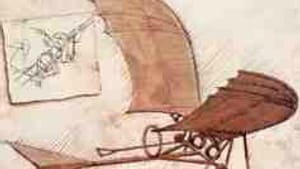Stay in the Loop
BSR publishes on a weekly schedule, with an email newsletter every Wednesday and Thursday morning. There’s no paywall, and subscribing is always free.
Inside Leonardo's mind
"Leonardo Da Vinci's Workshop' at Franklin Institute

It's been said that if Leonardo da Vinci were alive today he'd be known as a scientist who also dabbles in art. In 15th-Century Italy there were no scientists"“ science was in the air but not a viable occupation. So Leonardo was an artist, but the sort who could also design your silverware, plan your birthday parties and oversee the addition to your villa.
Leonardo, of course, was a one-of-a-kind genius, so he did things no other artist could do, as the Franklin Institute's exhibit clearly demonstrates. The Leonardo on display is the inventor of legend, the owner of the unique mind that could conceive of airplanes and bicycles and other mechanical marvels that wouldn't be possible for hundreds of years.
The entrance to the exhibit is its weakest part, staged for atmosphere like a Renaissance thrift shop, with the odd carved chair, patches of tapestry and a few dented metal goblets. An introductory text starts the visitor off with basic knowledge about Leonardo but also contains a few small, irritating errors. (It credits Leonardo with pioneering the use of oil paint, when that credit goes to the Northern artist Jan van Eyck; and a later label attributes a drawing to "9th century" artist/architect Villard de Honnecourt, who actually lived in the 13th Century.)
Digital Mona Lisa
Just before the exhibit proper, you find an easel with a digital version of the Mona Lisa, contrasting old technology— oil paints and palette— with new, claiming to show the famous work before crusty layers of dirt and yellowing varnishes intervened. It's a slow start, but then you step into the cavernous exhibit space and the excitement begins.
Here is a wonderland; everywhere you turn, you find constructed models from Leonardo's sketchbooks, with interactive touch screens that allow you to explore, construct, examine and play with his ideas and inventions. Leonardo would have loved it. I imagined him running with the kids— and adults"“ from one display to the next, soaking it all in, bending over the screens to see what he could find to do next, what new way of thinking and creating would open up before his eyes.
Leonardo's unlimited imagination is everywhere: practical inventions that improve on existing technology, such as the elegant "Swing Bridge" that swivels to facilitate or hamper traffic across a river; brutal war machines, never built but evidence of his troubled times; a combination harpsichord/viola, which brought to mind Leonardo's reputed musical gifts; and of course his dramatic futuristic flying machines.
Robot soldier
The carefully constructed models are accompanied by the appropriate codex pages of Leonardo's beautiful sepia sketches, with notes in his spidery reverse writing, and with labels to help viewers understand conception and construction. An elaborately outfitted Robot Soldier was an intriguing idea, but for me that was the biggest stretch between the doodles on the page and the constructed model.
Central to the exhibit is a Mechanical Lion that Leonardo invented as entertainment for Francois I, the French king who eventually took Leonardo"“ and the Mona Lisa"“ home with him. The life-sized lion was intended to walk, roar, and then, with a dramatic flourish, present the king with a bouquet of flowers.
Toward the end you'll encounter a large-scale digital presentation of The Last Supper, again claiming to represent, with the aid of modern technology, the "real" painting instead of the battered, badly disintegrated but recently restored actual work. Here, when the familiar images were made to look overly pretty, I found myself annoyed by the museum's "Look what we can do" approach to art and technology.
But these are mere quibbles. "Leonardo de Vinci's Workshop" is an exciting chance to follow the workings of one of the world's most amazing minds.
Leonardo, of course, was a one-of-a-kind genius, so he did things no other artist could do, as the Franklin Institute's exhibit clearly demonstrates. The Leonardo on display is the inventor of legend, the owner of the unique mind that could conceive of airplanes and bicycles and other mechanical marvels that wouldn't be possible for hundreds of years.
The entrance to the exhibit is its weakest part, staged for atmosphere like a Renaissance thrift shop, with the odd carved chair, patches of tapestry and a few dented metal goblets. An introductory text starts the visitor off with basic knowledge about Leonardo but also contains a few small, irritating errors. (It credits Leonardo with pioneering the use of oil paint, when that credit goes to the Northern artist Jan van Eyck; and a later label attributes a drawing to "9th century" artist/architect Villard de Honnecourt, who actually lived in the 13th Century.)
Digital Mona Lisa
Just before the exhibit proper, you find an easel with a digital version of the Mona Lisa, contrasting old technology— oil paints and palette— with new, claiming to show the famous work before crusty layers of dirt and yellowing varnishes intervened. It's a slow start, but then you step into the cavernous exhibit space and the excitement begins.
Here is a wonderland; everywhere you turn, you find constructed models from Leonardo's sketchbooks, with interactive touch screens that allow you to explore, construct, examine and play with his ideas and inventions. Leonardo would have loved it. I imagined him running with the kids— and adults"“ from one display to the next, soaking it all in, bending over the screens to see what he could find to do next, what new way of thinking and creating would open up before his eyes.
Leonardo's unlimited imagination is everywhere: practical inventions that improve on existing technology, such as the elegant "Swing Bridge" that swivels to facilitate or hamper traffic across a river; brutal war machines, never built but evidence of his troubled times; a combination harpsichord/viola, which brought to mind Leonardo's reputed musical gifts; and of course his dramatic futuristic flying machines.
Robot soldier
The carefully constructed models are accompanied by the appropriate codex pages of Leonardo's beautiful sepia sketches, with notes in his spidery reverse writing, and with labels to help viewers understand conception and construction. An elaborately outfitted Robot Soldier was an intriguing idea, but for me that was the biggest stretch between the doodles on the page and the constructed model.
Central to the exhibit is a Mechanical Lion that Leonardo invented as entertainment for Francois I, the French king who eventually took Leonardo"“ and the Mona Lisa"“ home with him. The life-sized lion was intended to walk, roar, and then, with a dramatic flourish, present the king with a bouquet of flowers.
Toward the end you'll encounter a large-scale digital presentation of The Last Supper, again claiming to represent, with the aid of modern technology, the "real" painting instead of the battered, badly disintegrated but recently restored actual work. Here, when the familiar images were made to look overly pretty, I found myself annoyed by the museum's "Look what we can do" approach to art and technology.
But these are mere quibbles. "Leonardo de Vinci's Workshop" is an exciting chance to follow the workings of one of the world's most amazing minds.
What, When, Where
"Leonardo da Vinci's Workshop." Through May 22, 2011 at the Franklin Institute, 222 N. 20th St. (215) 448-1200 or www.fi.edu.
Sign up for our newsletter
All of the week's new articles, all in one place. Sign up for the free weekly BSR newsletters, and don't miss a conversation.

 Marilyn MacGregor
Marilyn MacGregor